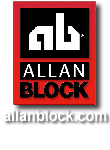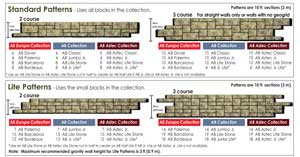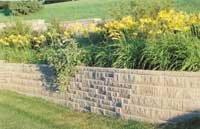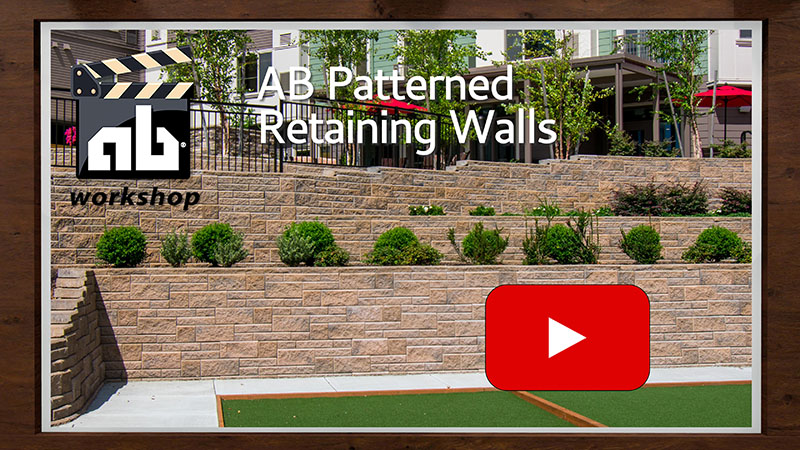Building Patterned Retaining Walls
Patterned retaining walls resemble hand-laid stone walls, and will require a certain level of detail and craftsmanship to construct. Some custom fitting of blocks will be required. Plan on taking a little extra time to build, particularly when building one for the first time.
Choosing the Right Pattern
Both the AB Collection and AB Europa Collections can be used to create a variety of pre-set and random patterns. (See the Pattern Chart for more details). A pre-set pattern is repeated every two or three courses of block.
A single course consists of a full size block, approximately 8 in. (200 mm) high. Random patterns used on a reinforced wall require a level surface every 2 courses for proper installation of geogrid. Check your approved plans for geogrid placement.
Note:
- Patterned walls will have a 6° setback.
- Walls with curves should always use the 2 course pattern to minimize cutting and fitting.
- For Standard Patterns, the base course needs to be a full course of full size blocks and for Lite Patterns, half width blocks. For each 10 ft. (3 m) length you will need the equivalent of 7 full size blocks.
A Dash of Ashlar
The AB Collections have been created in modular sizes to allow for easy construction of patterned walls. Selected areas of non-patterned walls can also contain patterns. With the modular design, the blocks can be installed with ease.
Pattern Construction Tips
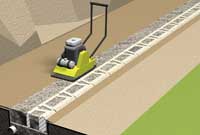
Install base course with full size units and compact
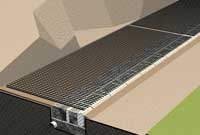
Install geogrid
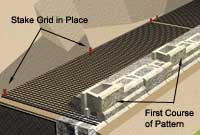
Stack first course of pattern and backfill wall rock in block cores
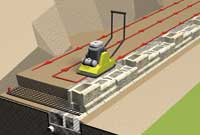
Compact wall rock and backfill materials parallel to the retaining wall
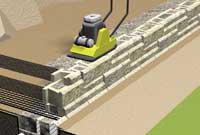
Compact on blocks first and then the wall rock and backfill materials when the pattern is completed

Install geogrid and additional patterns. Offset patterns to randomize the look
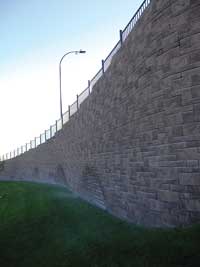
AB Ashlar Pattern Retaining Wall
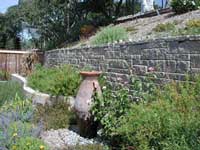
AB Abbey Blend Pattern Retaining Wall
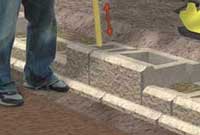
Compact retaining wall with shovel
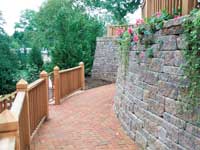
AB Abbey Blend patterned retaining wall
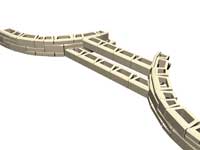
Patterned retaining wall with stairs

Patterned retaining wall with stairs

Patterned retaining wall with stairs

Patterned retaining wall with stairs
Excavation and Installing Base Course
Full-sized blocks should always be used for the base course with a Standard Pattern, and for Lite Patterns, half width blocks. This will speed the leveling and installation of the first course.
- Refer to the gravity wall instructions for a detailed description on how to install the base course. Basic steps include: site prep and excavation, installing base material, base course, wall rock, backfill materials, geogrid - if necessary and compacting.
Installing Reinforcement
Refer to the plans for placement of grid; this example requires grid on top of the base course.
- Remove all excess material and slag from the top surface of the base course. This prepares a smooth surface for placement of the geogrid and the next course of blocks.
- Cut sections of geogrid to specified lengths. Check manufacturer’s grid specifications for strength and roll or machine direction. Refer to the approved plans for exact size and location.
- Install the layer of geogrid by placing the cut edge up to the back of the raised front lip and roll the layer out to the back of the excavation area to the length specified in the approved plans.
- For retaining walls that require geogrid reinforcement, selection of which pattern to use is determined by the grid spacing shown on the approved plans. If grid is required every 2 courses, then use a 2 course pattern; if 3 course grid spacing is required, use a 3 course pattern.
- If building with a random pattern, the pattern must be leveled off at the appropriate courses to allow for the installation of geogrid on a flat surface.
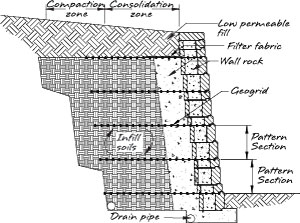
Patterned wall with reinforcement
Install the Multi-Course Pattern
The retaining wall example shown here uses a two (2) course pattern. Check the approved plans to determine the best pattern option for the project
- Stack the first course of the pattern on top of the geogrid and the base course.
- Check blocks for level, and make adjustments as needed. Pull on the back of the geogrid to remove any slack. If necessary, stake in place.
- Install the wall rock in the block cores and 12 in. (300 mm) behind the blocks to the height of the blocks.
- Compact inside the block cores using a shovel handle. Check blocks for level. Learn more about compaction in the block cores.
- Use infill or approved on-site soils to backfill behind the wall rockin the reinforced zone. The height of the wall rock and backfill material cannot exceed 8 in. (200 mm) before compacting. The top of the blocks will not always match up with each lift of soil.
- Using a mechanical plate compactor, compact the wall rock and infill materials behind the block in maximum 8 in. (200 mm) lifts. Compact directly behind the blocks in a path parallel to the wall, working from the back of the wall to the back of the excavated area. Compact to a minimum of 95% Standard Proctor.
- Check blocks for level. and then install the remainder of the 2 course pattern. Install wall rock in the block cores and behind the blocks as before. Use approved infill soils to backfill behind wall rock. Check blocks for level and for batter.
- With the first multiple-course pattern completed, use a plate compactor to compact the wall rock in the block cores and the wall rock behind the blocks. The first pass of the plate compactor should be directly over the top of the block cores.
- After running the plate compactor on top of the blocks and wall rock, compact the infill material immediately behind the wall. Compact in a path parallel to the wall, working from the front of the wall to the back of the infill material. Compact to a minimum of 95% Standard Proctor.
- Check and adjust for level and alignment and wall batter as the wall stacks up. It is acceptable to shim under blocks to compensate for a build up of tolerances or an out of level base condition. Asphalt shingles or geogrid work well when shims are required. The maximum allowable shim thickness per course is 1/8 in. (3 mm).
- Keep all heavy equipment at least 3 ft. (0.9 m) away from the back of the wall.
Installing the Second Multiple-Course Pattern
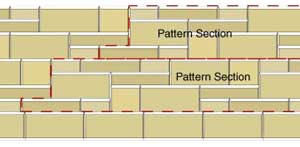
Offset the patterns
- Refer to your approved plans to determine if reinforcement will be required. If so, repeat the previous process to install geogrid between the patterns.
- Install the next pattern section as done in the previous steps. Each additional pattern will need to be offset from the pattern below to avoid a repetitive look. Remember to offset the vertical seams by at least 1/4 of the block whenever possible.
- Two course patterns should be selected for most projects. Three course patterns can be used for gravity walls or to top off a reinforced wall where geogrid is not required within the top three courses.
Ending and Topping off the Retaining Wall

Ending patterned retaining walls
Patterned walls may be ended with a step-down or a turn-in. When ending a patterned wall, discontinue the pattern and randomly adjust as necessary to meet the site conditions.
- Finishing a patterned wall is the same as finishing a standard retaining wall. The only requirement is that a multiple course pattern must be completed so that the top course of blocks forms a level surface.
- Use 8 in. (200 mm) of impermeable fill on the last lift to finish off wall.
Compacting Patterned Retaining Walls
- Compaction in the block cores needs to be done regularly when working with patterned walls. This can be done by using the end of a shovel to compact the wall rock, adding additional rock if necessary.
- At each 8 in. (200 mm) lift, compact the block cores with the end of a shovel, and the area directly behind the block with a plate compactor.
- At the conclusion of each pattern, the top of the wall will be level. Run the plate compactor over the top of the blocks to consolidate the wall rock. Place geogrid if required, and begin the next pattern.
Curves
When building curves, the 2 course pattern is easier to work with than the 3 course pattern. The 3 course pattern will require more custom fitting or cutting of blocks to ensure a tight fit.
Inside curved walls are easily constructed by maintaining a tight spacing at the front of the wall face. For tighter radii, it may be necessary to cut out parts of the bottom notch in order for the blocks to fit tightly together. See more on curve installation.
Outside curved walls The wall will “tighten” as the height increases. There are three methods to adjust for the tightening effect:
- On the first course of the pattern, open the spacing between blocks slightly so that the top course(s) of the pattern will need minimal cutting.
- Reduce the lengths of the blocks by shortening them, using a saw with a diamond blade.
- Remove parts of the bottom notch for the blocks to fit tightly together. See more on curve installation.
The best answer is to always use the 2 course pattern when building curves.
Corners
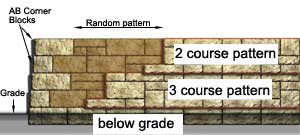
Patterned walls with corners
Outside corners are easily built using AB Corner Blocks.
- Start at the corner and build the wall working out in both directions
- When ending a patterned wall with a corner, use a random selection of blocks to transition from the patterned courses into the AB Corner Blocks.
Note: Always start the base course at the lowest elevation, then beginning additional courses at the corner will minimize cutting.
Inside corners are constructed in the same manner as for non-patterned walls.
- Remove the top lip of the course where the walls intersect. See more on corner installation.
Stairs
When building steps into patterned walls, use the full-sized AB Blocks for step blocks. See more on stair construction details.
Step-Ups
When building a retaining wall always start the base course at the lowest elevation. See more information on base construction.
Construction Tips for Patterned Retaining Walls
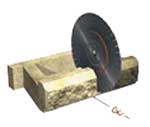
Cutting block in half
- When building an AB Ashlar Blend or an AB Aztec Blend retaining wall, if an AB Junior Lite or AB Aztec Jr Lite is not available, the AB Lite Stones or AB Aztec Lite Stones can be cut to produce two (2) AB Half Lites. It is good practice to pre-cut the desired number of blocks ahead of time to speed up the installation process.
- Offset each new pattern from the pattern below to maintain the "random" appearance.
- Use a two (2) course pattern on retaining walls that have numerous inside and outside curves. This will speed up the installation process.
- Use the two (2) course pattern when building a patterned curve. It is easier to work with than the three (3) course pattern. Learn how to build curves with this easy step-by-step process. To build tighter inside or outside curves learn how here.

